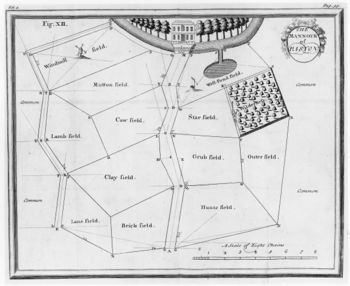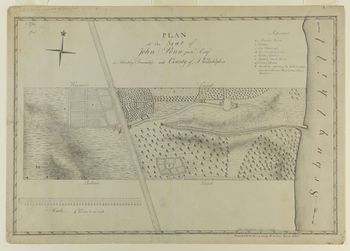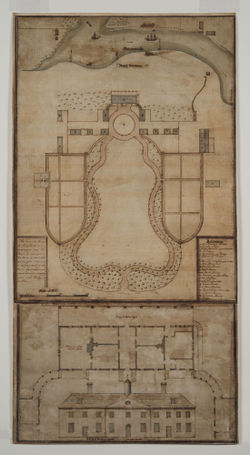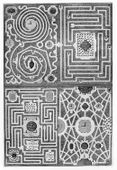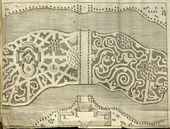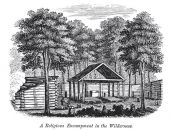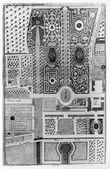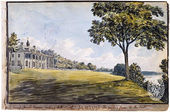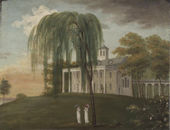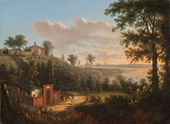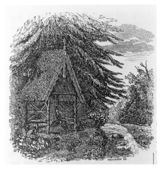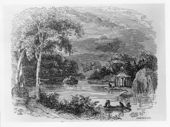Wilderness
See also: Copse, Grove, Thicket, Wood
History
When used in the context of 17th-and 18th-century gardens, the term wilderness generally referred to a planned arrangement of trees that contained an understory of vegetation, often set within a regularly defined space [Fig. 1].[1] According to Batty Langley (1728), usually this feature was located in a remote region of the garden. Philip Miller, in his 1754 treatise, insisted that wildernesses be located some distance from the house, so that moisture from the trees would not harm the dwelling. He also believed that the feature should not “obstruct any distant Prospect of the Country” and recommended that it be developed on a scale proportionate with the rest of the garden.
Elaborately patterned walks helped establish the internal design of the wilderness and encouraged strolling. These walks, typically framed by vegetation, could range from rectilinear to serpentine, as Langley's designs demonstrate. Miller maintained that wilderness walks should meander and contain quick turns to surprise the visitor with hidden features. In The Gardeners Dictionary (1754), American plants were listed under the category “wilderness,” a garden type that Miller recommended be laid out with serpentine walkways as if re-creating the untamed environment in which the plants were found originally.[2]
In the 17th and early 18th centuries, wilderness walks were typically bordered by dense, high hedges, as suggested by Richard Bradley (1719). Increasingly, these hedges were either trimmed to a low height or removed altogether in favor of shrubs underplanted with flowers. This shift in taste is indicated by Miller's treatise, in which he criticized high hedges and recommended lining the walks of the wilderness with irregularly disposed “Wood-flowers” (such as violets and daffodils), backed by low flowering shrubs (such as roses and honeysuckles). This method created a graduated slope of shrubs culminating in the grouping of trees. Eventually, this manner of arranging a wilderness became more commonly known as shrubbery in horticultural manuals. [3]
The emergence of such shrubbery, however, did not mean the immediate demise of the wilderness, nor did it mean that the new use of the term “shrubbery” correlated precisely with the old. [4] Shrubberies were typically characterized by decorative plantings arranged with respect to height in graduated slopes, and it is clear from Miller's account that wildernesses could be similarly arranged. Nonetheless, some differences distinguish the two features. Most significantly, a wilderness (unlike a shrubbery) was often arranged in geometrical fashion, with regularized plantings punctuated by a centrally placed decorative object, such as a fountain or statue. The illusion of density in wilderness vegetation often was created by planting trees in a quincunx pattern (resembling the arrangement of a five-face on a die), a plan not generally used in shrubberies.
A few colonial wildernesses were constructed in a manner roughly comparable to that described by Miller and Langley.[5] A 1734 real estate advertisement for a South Carolina island, for example, noted a shady wilderness filled with walks and arbors. John Penn and George Washington each built a wilderness on his estate, placing the feature at a distance from the main house, in keeping with Langley's prescriptions. In John Nancarrow’s c. 1784 plan of John Penn's estate in Philadelphia, the wilderness is labeled at “c” [Fig. 2]. In his plan for Mount Vernon [Fig. 3], Samuel Vaughan in 1787 depicted wildernesses flanking the serpentine walks and eventually merging at some distance from the main house. In practice, Washington did not follow Vaughan's recommendation but kept the area clear to form a view framed by wildernesses, as his contemporaries Langley and Miller recommended. According to Washington's diaries, the wildernesses at Mount Vernon were also intersected with walks, although such details are not noted on Vaughan’s plan of the estate. In keeping with the elision between the terms “wilderness” and “shrubbery” in this period, Washington sometimes referred to these planting features as shrubberies.
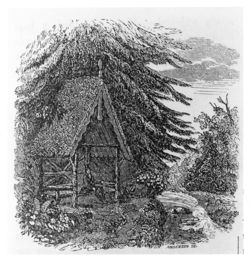
The term “wilderness” persisted in early 19th-century American horticultural manuals. Bernard M’Mahon (1806), for example, emphasized winding walks framed by closely planted vegetation and occasionally leading to open spaces also bounded by plantations. By this date, however, the term already was waning in importance. The Encyclopaedia (1798) denounced the “stars and other ridiculous figures” that sometimes appeared in wilderness plans. When Noah Webster defined wilderness in his dictionary of 1828, the landscape definition term was listed last and was explained only briefly as “a wood in a garden, resembling a forest.” When A. J. Downing in 1847 referred to “The Wilderness” at Montgomery Place, in Dutchess County, NY, he referred to the recreation of a native woodland [Fig. 4] and not to a feature consistent with discussions found in earlier gardening treatises. Downing's evocative description of a “richly wooded valley,” where one could imagine oneself “in the depths of an old forest, far away from the haunts of civilization,” reflects a central trope in 19th-century American culture, representing the wilderness as a primeval forest. The later definition shaped not only aesthetics but also the nation’s sense of self-identity. Thus the wilderness in American gardens evolved from an artificially constructed space set apart from the natural landscape to an unimproved natural landscape included within the conception of the garden.
—Anne L. Helmreich
Texts
Usage
- Anonymous, February 9, 1734, describing a property for sale on Hog-Island, near Charleston, SC (South Carolina Gazette)
- “On the Island is a New Dwelling House [with]. . . A delightful Wilderness with shady Walks and Arbours, cool in the hottest Seasons. A piece of Garden-ground where all the best kinds of Fruits and Kitchen Greens are produced planted with Orange-, Apple-, Peach-, Nectarine-, and Plumb-trees.”
- Fisher, Daniel, May 25,1755, describing the Proprietor’s Garden, Philadelphia, PA (quoted in Pecquet du Bellet 1907: 2:801–2)[6]
- “The Proprietor’s tho’ much smaller, was laid out with more Judgement, tho’ it seems to have been pretty much neglected, a pretty pleasure garden . . . a small Wilderness, and other shades, shows that the contrivor was not without Judgement.”
- Washington, George, 1785, describing Mount Vernon, plantation of George Washington, Fairfax County, VA (Jackson and Twohig, eds., 1978: 4:75, 103–7)[7]
- “[January 12] Road to my Mill Swamp, where my Dogue run hands were at work & to other places in search of the sort of Trees I shall want for my walks, groves, & Wildernesses.
- “At the Sein Landing & between that & the point at the old Brick kiln I found about half a dozn. young Elm trees, but not very promising ones. Many thriving ash trees on high (at least dry) ground of proper size for transplanting and a great abundance of the red-bud of all sizes. In the field which I bought of Barry & Miss Wade along the drain, & prongs of it, are one or two more; but rather of large size—but in the latter (a prong of the drain in Barry’s field) there are great abundance of the white thorn (now full of the red Berries in clusters). Within the Meadow fence at the Mill, & within that Inclosure next Isaac Gates’s are some young Crab apple trees and young Pine trees in the old field of all sizes. And in the Branch of Hell hole betwn. the Gate & its mouth are a number of very fine young Poplars—Locusts— Sasafras and Dogwood. Some Maple Trees on high ground & 2 or 3 Shrubs (in wet ground) wch. I take to be of the Fringe tree. . .
- “[March 17] Laid out a walk for the Wilderness intended on the South of the Serpentine road on the left. . .
- “[March 18] I went to my Dogue run Plantation to make choice of the size, & to direct the taking up of Pine trees, for my two wildernesses. Brought 3 waggon load of them home, and planted every other hole round the Walks in them. Began with that on the right, which was planted before the wet fell, & better planted; that is with more pains the other (on the left) being hurried more and the ground wet and sticky. . .
- “[March 21] Staked up the largest of my Trees in the avenues and Wilderness and Shrubberies to day, which from the softness of the ground & impression made on them by the Wind were leaning. . .
- “[March 22] Mrs. Grayson sent me 8 Yew & 4 Aspan trees & Colo. Mason some Cherry Grafts. Planted the intermediate holes round the Walk in the Wilderness on the right and filled the spaces between with young Pines. . .
- “[March 24] Finding the Trees round the Walks in my wildernesses rather too thin I doubled them by putting (other Pine) trees between each.
- “Laid off the Walks in my Groves, at each end of the House.”
- Constantia [Judith Sargent Murray], June 24, 1790, “Description of Gray’s Gardens, Pennsylvania” (Massachusetts Magazine 3: 414–15)[8]
- “this, as well as all the smaller avenues, alike produces us in the wilderness, into which we enter, passing over a neat chinese bridge, preparing with much pleasure to penetrate a recess so charming. It is indeed a wilderness of sweets, and the views instantly become romantically enchanting, the scene is every moment changing. Now, side long bends the path; then, pursues its winding way; now, in a straight line; then, in a pleasing labyrinth is lost, until, in every possible direction, it breaketh upon us, amid thick groves of pines, walnuts, chestnuts, mulberries, &c. &c. we seem to ramble, while at the same time, we are surprized [sic] by borders of the richest, and most highly cultivated flowers, in the greatest variety, which even from a royal parterre we might be led to expect.”
- Jefferson, Thomas, September 4, 1804, describing Monticello, plantation of Thomas Jefferson, Charlottesville, VA (quoted in Nichols and Griswold 1978: 112)[9]
- “The Broom wilderness on the South side to be improved for winter walking or riding, conducting a variety of roads through it, forming chambers with seats, well sheltered from winds, & spread before the sun. a temple with yellow glass panes would suit these, as it would give the illusion of sunshine in cloudy weather.”
- Martineau, Harriet, May 4, 1835, describing New Orleans, LA (1838: 1:274)[10]
- “In returning, we alighted at one of these delicious retreats [villas], and wandered about, losing each other among the thorns, the ceringas, and the wilderness of shrubs. We met in a grotto, under the summer-house, cool with a greenish light, and veiled at its entrance a tracery of creepers. There we lingered, amid singing or silent dreaming. There seemed to be too little that was real about the place for ordinary voices to be heard speaking about ordinary things.”
- Downing, Andrew Jackson, October 1847, describing Montgomery Place, country home of Mrs. Edward (Louise) Livingston, Dutchess County, NY (quoted in Haley 1988: 47–48)[11]
- “Leaving the morning walk, we enter at once into ‘The Wilderness.’ This is a large and long wooded valley. It is broad, and much varied in surface, swelling into deep ravines, and spreading into wide hollows. In its lowest depths runs a large stream of water, that has, in portions, all the volume and swiftness of a mountain torrent. But the peculiarity of ‘The Wilderness,’ is in the depth and massiveness of its foliage. It is covered with the native growth of trees, thick, dark and shadowy, so that once plunged in its recesses, you can easily imagine yourself in the depths of an old forest, far away from the haunts of civilization. . .
- “But the Wilderness is by no means savage in the aspect of its beauty; on the contrary, here as elsewhere in this demesne, are evidences, in every improvement, of a fine appreciation of the natural charms of the locality. The whole of this richly wooded valley is threaded with walks, ingeniously and naturally conducted so as to penetrate to all the most interesting points; while a great variety of rustic seats, formed beneath the trees, in deep secluded thickets, by the side of the swift rushing stream, or on some inviting eminence, enables one fully to enjoy them.” [See Fig. 4]
Citations
- Parkinson, John, 1629, Paradisi in Sole Paradisus Terrestris (1629: 5)[12]
- “For there may be therein [the garden] walkes eyther open or close, eyther publike or private, a maze or wildernesse.”
- Bradley, Richard, 1719, New Improvements of Planting and Gardening (1719: 1.2:17, 18, 43)[13]
- “It [the Yew-Tree] is of great use for Hedges, and make most agreeable Divisions in Gardens; it is customary to fence in the Quarters of Wilderness Works with these Plants, where they have a very good Effect. . .
- “[the Laurus-tinus] is often train’d up to a headed Plant, and introduced among Hollys and Yews into the Parterre. But I should rather direct that it be planted against a Wall or in Wildernesses, where it may avoid the Knife for the sake of its Flowers. . .
- “Small Walks of these [Lilac] Trees are very pleasant, and they are no less Ornamental in the Quarters of Wilderness Works, especially if the White flowering Kind be judiciously intermix’d with them.”

- Langley, Batty, 1728, New Principles of Gardening (1728; repr., 1982: xi, xi [page numbers are not distinctively sequential], 195–200)[14]
- “Their Wildernesses and Groves [of the nobility and gentry] (when they planted any) were always placed at the most remote Parts of the Garden: So that before we can enter them, in the Heat of Summer, when they are most useful, we are obliged to pass thro’ the scorching Heat of the Sun.
- “Indeed, ’tis oftentimes necessary to place Groves and open Wildernesses in such remote Parts of Gardens, from whence pleasant Prospects are taken; but then we should always take care to plant proportionable Avenues leading from the House to them, under whose Shade we might with Pleasure pass and repass at any time of the Day. . .
- “Plate V. is a third Design of an Avenue with its Wildernesses on each Side, wherein is contain’d great Variety of Walking. . . [Fig. 5]
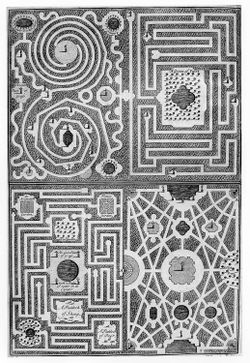
- “Plate VII. consists of four several Designs for Wildernesses and Labyrinths wherein A A, &c. are Arbors, or Places of Repose. [Fig. 6]
- “General DIRECTIONS, &c. . . .
- “X. That all those Parts which are out of View from the House, be form’d into Wildernesses, Labyrinths, &c. . . .
- “XVI. That the Walks of a Wilderness be never narrower than ten Feet, or wider than twenty five Feet.
- “XVII. That the Walks of a Wilderness be so plac’d, as to respect the best Views of the Country. . .
- “XIX. That in those serpentine Meanders, be placed at proper Distances, large Openings, which you surprizingly come to. . .
- “These agreeable surprizing Entertainments in the pleasant Passage thro’ a Wilderness, must, without doubt, create new Pleasures at every Turn. . .
- “XXIII. In the Planting of a Wilderness, be careful of making an equal Disposition of the several Kinds of Trees, and that you mix therewith the several Sorts of Ever-Greens; for they not only add a very great Beauty thereunto, by their different Leaves and Colours, in the Summer; but are a great Grace to a Garden in the Winter, when others have stood the Strip of their Leaves.”
- Chambers, Ephraim, 1741–43, Cyclopaedia (1741–43: 2:n.p.)[15]
- “QUINCUNX is chiefly used in gardening, for a plantation of trees, disposed originally in a square; consisting of five trees, one at each corner, and a fifth in the middle; which disposition repeated again and again, forms a regular grove, wood, or wilderness, and then viewed by an angle of the square, or parallelogram, presents equal and parallel alleys. . .
- “WILDERNESS, See DESART, GROVE, LABYRINTH, &c.”
- Miller, Philip, 1754, The Gardeners Dictionary (1754; repr., 1969: 1523–33)[16]
- “WILDERNESSES, if rightly situated, artfully contrived, and judiciously planted, are very great Ornaments to a fine Garden; but it is rare to see these so well executed in Gardens as could be wish’d, nor is it often they are judiciously situated: for either they are so situated as to hinder a distant Prospect, or else are not judiciously planted: the latter of which is scarce ever to be found in any of our most magnificent Gardens, very few of their Designers ever studying the natural Growth of Plants, so as to place them in such manner, that they may not obstruct the Sight from the several Parts of the Plantation which are presented to the View. . .
- “1. Wildernesses should always be proportion’d to the Extent of the Gardens in which they are made, that they may correspond in Magnitude with the other Parts of the Garden; for it is very ridiculous to see a large Wilderness planted with tall Trees in a small Spot of Ground; and, on the other hand, nothing can be more absurd, than to see little paltry Squares or Quarters of Wilderness-work, in a magnificent large Garden.
- “2. As to the Situation of Wildernesses, they should never be placed too near the Habitation; because the great quantity of Moisture which is perspired from the Trees, will cause a damp unwholesome Air about the House, which is often of ill Consequence: nor should they be situated so as to obstruct any distant Prospect of the Country; which should always be preserved wherever it can be obtained; there being nothing so agreeable to the Mind as an unconfined Prospect of the adjacent Country. But where the Sight is confined within the Limits of the Garden from its Situation, then there is nothing so agreeable to terminate the Prospect, as a beautiful Scene of the various Kinds of Trees judiciously planted; and if it is so contrived, that the Termination is planted circularly, with the Concave toward the Sight, it will have a much better Effect, than if it end in strait Lines or Angles, which are never so agreeable to the Mind.
- “3. The Plants should always be adapted to the Size of the Plantation; for ’tis very absurd to see tall Trees planted in small Squares of a little Garden; and so likewise, if in large Designs are planted nothing but small Shrubs, it will have a mean Appearance. It should also be observed, never to plant Ever-greens amongst deciduous Trees; unless it be toward the Front or Borders of the Plantation chiefly in Sight; because these afford a continual Pleasure both in Summer and Winter, when in the latter Season the deciduous Trees do not appear so agreeable: therefore, if the Borders of the Wilderness-quarters are skirted with Ever-green, they will have a good Effect.
- “4. The Walks must also be proportion’d to the Size of the Ground, and not make large Walks in a small Wilderness (nor too many Walks, though smaller), whereby the greatest Part of the Ground is employ’d in Walks: nor should the grand Walks of a large Wilderness be too small, both of which are equally faulty. These Walks should not be enter’d immediately from those of the Pleasure-Garden; but rather be led into by a small private Walk, which will render it more entertaining: or if the large Walk be turned in Form of a Serpent, so as not to shew its whole Extent, the Mind will be better pleas’d, than if the Whole were open to the View.
- “The usual Method of contriving Wilderness is, to divide the whole Compass of Ground, either into Squares, Angles, Circles, or other Figures, making the Walks correspondent to them; planting the Sides of the Walks with Hedges of Lime, Elm, Hornbeam, &c. and the Quarters within are planted with various Kinds of Trees promiscuously without Order. But this can by no means be esteemed a judicious Method; because hereby there will be a great Expence in keeping the Hedges of a large Wilderness in good Order, which, instead of being beautiful, are rather the reverse; for as these Parts of a Garden should, in a great measure, be design’d from Nature, so whatever has the stiff Appearance of Art does by no means correspond therewith. Besides, these Hedges are generally trained up so high, as to obstruct the Sight from the Trees in the Quarters, which ought never to be done.
- “In the next place, the Walks are commonly made to intersect each other in Angles; which also shews too formal and trite for such Plantations, and are by no means comparable to such Walks as have the Appearance of Meanders or Labyrinths, where the Eye cannot discover more than twenty or thirty Yards in Length; and the more these Walks are turn’d, the greater Pleasure they will afford. These should now and-then lead into an open circular Piece of Grass; in the Centre of which may be plac’d either an Obelisk, Statue, or Fountain; and if in the middle Part of the Wildernesses there be contrived a large Opening, in the Centre of which may be erected a Dome or Banqueting-house, surrounded with a green Plot of Grass, it will be a considerable Addition to the Beauty of the Place.
- “From the Sides of the Walks and Openings, the Trees should rise gradually one above another to the Middle of the Quarters, where should always be planted the largest-growing Trees, so that the Heads of all the Trees will appear to the View; but their Stems will be hid from Sight, which will have a vastly different Effect from the common Method, where the Trees are planted large and small without any Order; so that many times the largest are next the Sight, and small ones behind them, just according as it happens; in which manner the small ones, being overhung and shaded, seldom thrive well.
- “But in order to plant a Wilderness with Judgment, the usual Growth of all the different Sorts of Trees should be well consider’d, that each may be placed according to the Magnitude to which they generally grow; otherwise, if they are at first planted one above another, as before directed, they will not continue to grow in this Order many Years; for some Sorts will greatly outgrow the others, and thereby render the Plantations less beautiful; but when they are placed according to their usual manner of growing, they will always continue nearly in the same Order, which renders them very entertaining to the Sight.
- “By this Distribution you will have the Pleasure of the flowering Shrubs near the Sight, whereby you will be regaled with their Scent, as you pass through the Walks; which is seldom observed by those who plant Wildernesses; for nothing is more common than to see Roses, Honeysuckles, and other small flowering Shrubs, placed in the Middle of large Quarters, under the Dropping and Shade of large Trees, where they seldom thrive; and if they do, the Pleasure of them is lost, because they are secluded from the Sight. . .
- “But, beside these grand Walks and Openings (which should always be laid with Turf, and kept well mowed), there should be some smaller Serpentine-walks through the Middle of the Quarters, where Persons may retire for Privacy. . . By the sides of these private Walks may also be scattered some Wood-flowers and Plants, which, if artfully planted, will have a very good Effect.
- “In the general Design for these Wildernesses, it should not be studied to make the several Parts correspondent; for that is so formal and stiff, as to be now quite rejected: the greater Diversity there is in the Distribution of these Parts, the more Pleasure they will afford: and since, according to this Method of Designing and Planting, the different Parts never present themselves to the same Views, it is no matter how different they are varied asunder; that Part of them which is most in View from the House, or other Parts of the Garden, may be planted with Evergreens; but the other Parts may be planted with deciduous Trees in the foregoing manner.
- “By what I have said concerning the Planting of the Trees in Rows, one behind another, according to their different Growths, I would not have it understood, that I mean the placing them in strait Lines, which is too stiff and formal for these Plantations: all that is intended is, to place the front Rows of Trees on each Side the Walks, at an equal Distance from the Sides of the Walks; so that the Lines of Trees (especially the three first) will turn in the same manner as the Walks. Those behind may be placed after the same manner, provided Care be taken to allow each sufficient room to grow, and that there may appear no uneven Gaps in the Distance of their Heads; but that they may all rise gradually, so as to form an handsome Slope.
- “In small Gardens, where there is not room for these magnificent Wildernesses, there may be some rising Clumps of Ever-greens, so designed as to make the Ground appear much larger than it is in Reality; and if in these there are some Serpentine-walks well contriv’d, it will greatly improve the Places, and deceive those who are unacquainted with the Ground, as to its size. These Clumps or little Quarters of Evergreens should be placed just beyond the plain Opening of Grass before the House, where the Eye will be carried from the plain Surface of Grass, to the regular Slope of Evergreens, to the great Pleasure of the Beholder; but if there is a distant Prospect of the adjacent Country from the House, then this should not be obstructed, but rather a larger Opening allowed for the View, bounded on each Side with these rising Clumps, which may be extended to half the Compass of the Ground: and on the back Part from the Sight, may be planted the several Kinds of flowering Shrubs, according to their different Growths, which will still add to the Variety. These small Quarters should not be surrounded with Hedges, for the Reasons before given for the larger Plantations; nor should they be cut into Angles, or any other studied Figures, but be designed rather in a rural manner; which is always preferable to the other, for these Kinds of Plantations. . .
- “Where Persons have the Convenience of grown Woods near the Habitation, so as that there may be an easy Communication from one to the other, there will be little Occasion for Wildernesses in the Garden; since the natural Woods may be so contriv’d, as to render them much pleasanter than any new Plantation can possibly arrive to within the Compass of twenty Years. . . there is not only the Pleasure of enjoying a present Shade from these Woods, but also a great Expence saved in the planting of Wildernesses.”
- Sheridan, Thomas, 1789, A Complete Dictionary of the English Language (1789: n.p.)[17]
- “WILDERNESS, wil’-der-nis. s. A desart, a tract of solitude and savageness; the state of being wild or disorderly. . .
- “WILDNESS, wi’ld-nis. s. Rudeness, disorder like that of uncultivated ground. . . irregularity.”
- Anonymous, 1798, Encyclopaedia (1798: 7:542)[18]
- “When wildernesses are intended, they should not be cut into stars and other ridiculous figures, nor formed into mazes or labyrinths, which in a great design appear trifling.”
- M’Mahon, Bernard, 1806, The American Gardener’s Calendar (1806: 57–58, 67)[19]
- “This ground must be more contracted as it approaches, near the mansion, that company may the sooner arrive in the walks of the shrubbery, wilderness, &c. under the shade and shelter of trees; but the outward extension on each boundary, should widen gradually towards the extreme termination, to give an air of grandeur, and admit of a full prospect from and to the mansion. . .
- “Another division sometimes to diversify the scenery, presents a Wilderness, in irregular partitions of plantations, having intervening spaces of grass-ground, and gravel-walks, extending in various directions; some by winding mazes or labyrinths, into openings formed in different parts; the boundary plantation of this division, being generally planted in close assemblage, with serpentine walks between; some leading in private meanders towards the interior parts, or breaking out sometimes into other walks that are open and spacious, both of grass, and gravel occasionally; conducted in serpentine turns, to cause the greater variety; some places being closely bordered with tall trees, to effect a gloominess and perfect shade: the different walks leading now and then into circular openings, each being surrounded with plantations as aforesaid; making the principal walks terminate in a grand opening in the centre of the wilderness, in which may be some ornamental edifice, or fine piece of water, &c. . . .
- “A Labyrinth, is a maze or sort of intricate wilderness-plantation, abounding with hedges and walks, formed into many windings and turnings, leading to one common centre, extremely difficult to find out; designed in large pleasure-grounds by way of amusement.”
- Webster, Noah, 1828, An American Dictionary of the English Language (1828: n.p.)[20]
- “WIL’DERNESS, n. [from wild.] A desert; a tract of land or region uncultivated and uninhabited by human beings, whether a forest or a wide barren plain. In the United States, it is applied only to a forest. In Scripture, it is applied frequently to the deserts of Arabia. The Israelites wandered in the wilderness forty years.
- “2. The ocean. . .
- “3. A state of disorder. . .
- “4. A wood in a garden, resembling a forest.”
Images
Inscribed
Batty Langley, “Design of an Avenue with its Wildernesses on each Side,” in New Principles of Gardening (1728), pl. V.
Batty Langley, “Several Designs for Wildernesses and Labyrinths,” in New Principles of Gardening (1728), pl. VII.
Associated
Samuel Vaughan, Plan of Mount Vernon, 1787.
Benjamin Henry Latrobe, View of Mount Vernon looking to the North, July 17, 1796.
Victor de Grailly, The Tomb at Mount Vernon, c. 1840—50.
Anonymous, “Rustic Seat,” Montgomery Place, in A. J. Downing, ed., Horticulturist 2, no. 4 (October 1847): 157, fig. 26.
Anonymous, “The Lake,” Montgomery Place, in A. J. Downing, ed., Horticulturist 2, no. 4 (October 1847): 158, fig. 27.
Notes
- ↑ Mark Laird, The Flowering of the Landscape Garden: English Pleasure Grounds, 1720–1800 (Philadelphia: University of Pennsylvania Press, 1999), 8, view on Zotero. In investigating the planting features of the 18th-century landscape garden, Laird’s text examines the historical development of the wilderness and its relationship to such related features as shrubbery.
- ↑ Laird, The Flowering of the Landscape Garden, 97–98. Laird notes that the wilderness was seen as the appropriate “home away from home” for American shrubs and trees. view on Zotero.
- ↑ Laird 1999, 101, view on Zotero.
- ↑ Laird 1999, 101–2, view on Zotero.
- ↑ Barbara Paca-Steele and St. Clair Wright have identified a wilderness garden at the William Paca house and garden in Annapolis, MD Barbara Paca-Steele with St. Clair Wright, “The Mathematics of an Eighteenth-Century Wilderness Garden,” Journal of Garden History 6, no. 4 (1986): 299–320, view on Zotero.
- ↑ Louise Pecquet du Bellet, ed., Some Prominent Virginia Families, 4 vols. (Lynchburg, VA: J. P. Bell, 1907), view on Zotero.
- ↑ George Washington, The Diaries of George Washington, ed. by Donald Jackson and Dorothy Twohig, 6 vols. (Charlottesville, VA: University Press of Virginia, 1978), view on Zotero.
- ↑ Constantia [Judith Sargent Murray], “Description of Gray’s Gardens, Pennsylvania,” Massachusetts Magazine, or, Monthly Museum of Knowledge and Rational Entertainment 7, no. 3 (July 1791): 413–17, view on Zotero.
- ↑ Frederick Doveton Nichols and Ralph E. Griswold, Thomas Jefferson, Landscape Architect (Charlottesville, VA: University Press of Virginia, 1978), view on Zotero.
- ↑ Harriet Martineau, Retrospect of Western Travel, 2 vols. (London: Saunders and Otley, 1838), view on Zotero.
- ↑ Jacquetta M. Haley, ed., Pleasure Grounds: Andrew Jackson Downing and Montgomery Place (Tarrytown, NY: Sleepy Hollow Press, 1988), view on Zotero.
- ↑ John Parkinson, Paradisi in Sole Paradisus Terrestris (London: Humfrey Lownes and Robert Young, 1629), view on Zotero.
- ↑ Richard Bradley, New Improvements of Planting and Gardening, Both Philosophical and Practical; Explaining the Motion of the Sapp and Generation of Plants. With Other Discoveries Never before Made in Publick, for the Improvement of Forest-Trees, Flower-Gardens or Parterres; with a New Invention Where by More Designs of Garden Platts May Be Made in an Hour, than Can Be Found in All the Books Now Extant. Likewise Several Rare Secrets for the Improvement of Fruit-Trees, Kitchen-Gardens, and Green-House Plants., 3rd ed., 2 vols. (London: W. Mears, 1719), view on Zotero.
- ↑ Batty Langley, New Principles of Gardening, or The Laying out and Planting Parterres, Groves, Wildernesses, Labyrinths, Avenues, Parks, &c. (London: A. Bettesworth and J. Batley, etc., 1728; repr., New York: Garland, 1982), view on Zotero.
- ↑ Ephraim Chambers, Cyclopaedia, or An Universal Dictionary of Arts and Sciences. . . , 5th ed., 2 vols. (London: D. Midwinter et al., 1741), view on Zotero.
- ↑ Philip Miller, The Gardeners Dictionary (1754; repr., New York: Verlag Von J. Cramer, 1969), view on Zotero.
- ↑ Thomas A. Sheridan, A Complete Dictionary of the English Language, Carefully Revised and Corrected by John Andrews. . . , 5th ed. (Philadelphia: William Young, 1789), view on Zotero.
- ↑ Anonymousa, Encyclopaedia, or A Dictionary of Arts, Sciences, and Miscellaneous Literature, 18 vols. (Philadelphia: Thomas Dobson, 1798), view on Zotero.
- ↑ Bernard M’Mahon, The American Gardener’s Calendar: Adapted to the Climates and Seasons of the United States. Containing a Complete Account of All the Work Necessary to Be Done. . . for Every Month of the Year. . . , (Philadelphia: Printed by B. Graves for the author, 1806), view on Zotero.
- ↑ Noah Webster, An American Dictionary of the English Language, 2 vols. (New York: S. Converse, 1828), view on Zotero.
